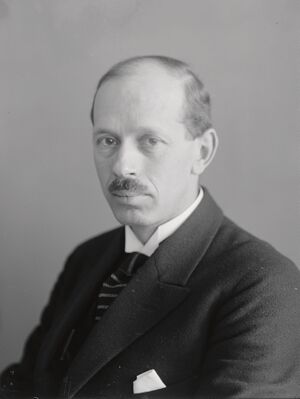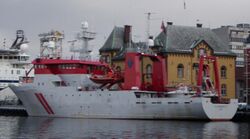هارالد سڤردروپ (عالم محيطات)
Harald Sverdrup | |
|---|---|
 | |
| وُلِدَ | 15 نوفمبر 1888 Sogndal, Sogn og Fjordane, Norway |
| توفي | 21 أغسطس 1957 (aged 68) |
| القومية | Norwegian |
| المدرسة الأم | University of Oslo University of Leipzig |
| عـُرِف بـ | Geophysical fluid dynamics Ocean dynamics Physical oceanography Sverdrup balance Sverdrup wave Sverdrup’s Critical Depth Hypothesis Sverdrup (unit) |
| الجوائز | Vega Medal (1930) Alexander Agassiz Medal (1938) Patron's Medal (1950) William Bowie Medal (1951) |
| السيرة العلمية | |
| المجالات | Oceanography, meteorology |
| الهيئات | Geophysical Institute, University of Bergen Scripps Institution of Oceanography Norwegian Polar Institute |
| المشرف على الدكتوراه | Vilhelm Bjerknes |
| طلاب الدكتوراه | Walter Munk |
هارالد أولريك سڤردروپ Harald Ulrik Sverdrup (15 نوفمبر 1888 – 21 أغسطس 1957) كان عالم محيطات وأرصاد جوية نرويجي. He served as director of the Scripps Institution of Oceanography and the Norwegian Polar Institute.[1][2]
Background
He was born at Sogndal in Sogn og Fjordane, Norway. He was the son of Lutheran theologian Edvard Sverdrup (1861–1923) and Maria Vollan (1865–1891). His sister Mimi Sverdrup Lunden (1894–1955) was an educator and author. His brother Leif Sverdrup (1898–1976) was a General with the U.S. Army Corps of Engineers. His brother Einar Sverdrup (1895–1942) was CEO of Store Norske Spitsbergen Kulkompani.[3]
Sverdrup was a student at Bergen Cathedral School in 1901 before graduating in 1906 at Kongsgård School in Stavanger. He graduated cand. real. in 1914 from University of Oslo. He studied under Vilhelm Bjerknes and earned his Dr. Philos. at the University of Leipzig in 1917.[4]
السيرة
He was the scientific director of the North Polar expedition of Roald Amundsen aboard the Maud from 1918 to 1925. His measurements of bottom depths, tidal currents, and tidal elevations on the vast shelf areas off the East Siberian Sea correctly described the propagation of tides as Poincare waves. Upon his return from this long expedition exploring the shelf seas to the north of Siberia, he became the chair in meteorology at the University of Bergen.[5]
He was made director of California's Scripps Institution of Oceanography in 1936, initially for three years but the intervention of World War II meant he held the post until 1948. During 33 expeditions with the research vessel E. W. Scripps between 1938 and 1941, he produced a detailed oceanographic dataset off the coast of California. He also developed a simple theory of the general ocean circulation postulating a dynamical vorticity balance between the wind-stress curl and the meridional gradient of the Coriolis parameter, the Sverdrup balance. This balance describes wind-driven ocean gyres away from continental margins at western boundaries.[6]
After leaving Scripps, he became director of the Norwegian Polar Institute in Oslo and continued to contribute to oceanography, ocean biology, and polar research. In biological oceanography, his critical depth hypothesis (published in 1953) was a significant milestone in the explanation of spring blooms of phytoplankton.[7]
Sverdrup was a member of both the United States National Academy of Sciences,[8] the Norwegian Academies of Science, the American Academy of Arts and Sciences,[9] and the American Philosophical Society.[10] He served as President of the International Association of Physical Oceanography and of the International Council for the Exploration of the Sea (ICES). His many publications include his magnum opus The Oceans: Their Physics, Chemistry and General Biology by Sverdrup, Martin W. Johnson and Richard H. Fleming (1942, new edition 1970) which formed the basic curriculum of oceanography for the next 40 years around the world.[11][12][13]
The Sverdrup, a unit describing the volume of water transport in ocean currents is called after Sverdrup.[14] 1 Sv = 106 m3 per second.
Personal life
In 1928, he married Gudrun (Vaumund) Bronn (1893–1983) and adopted her daughter Anna Margrethe.[1]
Honors
He was awarded the William Bowie Medal by the American Geophysical Union, the Alexander Agassiz Medal of the National Academy of Sciences, the Patron's Medal of the Royal Geographical Society, the Vega Medal by the Swedish Society for Anthropology and Geography and the Swedish Order of the Polar Star.[15]
الذكرى
Sverdrup (Sv) is used in physical oceanography as an abbreviation for a volume flux of one million cubic meters per second.[16]
The Sverdrup Gold Medal Award was named in his honor by the American Meteorological Society.[17]
Norwegian research vessel M/S H.U. Sverdrup II is named in his honor.[18]
In 1977, the UK-APC named a series of peaks in Palmer Land, Antarctica the Sverdrup Nunataks after him.
| سبقه T. Wayland Vaughan |
Director of the Scripps Institution of Oceanography 1936–1948 |
تبعه Carl Eckart |
المراجع
- ^ أ ب Susan Barr (2014-08-28). "H U Sverdrup". Norsk biografisk leksikon. Retrieved June 1, 2018.
- ^ "Harald Ulrik Sverdrup (1936–1948)". Scripps Institution of Oceanography. 2013-01-16. Archived from the original on 2018-06-13. Retrieved June 1, 2018.
- ^ Jon Gunnar Arntzen. "Sverdrup". Store norske leksikon. Retrieved June 1, 2018.
- ^ قالب:Cite ANB
- ^ Eric L. Mills. "Harald Ulrik Sverdrup (1888–1957)". American Geophysical Union. Retrieved June 1, 2018.
- ^ William A. Nierenberg (1996). "Harald Ulrik Sverdrup, biographical memoir" (PDF). National Academy of Sciences. Retrieved June 1, 2018.
- ^ Sverdrup, H. U. (1 January 1953). "On Conditions for the Vernal Blooming of Phytoplankton". ICES Journal of Marine Science. 18 (3): 287–295. doi:10.1093/icesjms/18.3.287.
- ^ "Harald Sverdrup". www.nasonline.org. Retrieved 2023-04-07.
- ^ "Harald Ulrik Sverdrup". American Academy of Arts & Sciences (in الإنجليزية). 9 February 2023. Retrieved 2023-04-07.
- ^ "APS Member History". search.amphilsoc.org. Retrieved 2023-04-07.
- ^ Mosby, H. (January 1957). "Harald Ulrik Sverdrup". Tellus. 9 (4): 429–431. Bibcode:1957Tell....9..429M. doi:10.3402/tellusa.v9i4.9137.
- ^ Ismail-Zadeh, Alik; Beer, Tom (22 December 2009). "International Cooperation in Geophysics to Benefit Society" (PDF). EOS. 90 (51): 493–502. Bibcode:2009EOSTr..90..493I. doi:10.1029/2009EO510001. Archived (PDF) from the original on 2010-08-06.
- ^ Lenz, Walter (2002). "ICES involvement in IGY 1957/58 with special emphasis on marine biology" (PDF). ICES Marine Science Symposia. 215: 132–137. Archived (PDF) from the original on 2018-06-13.
- ^ Eldevik, Tor; Haugan, Peter Mosby (April 2020). "That's a lot of water". Nature Physics. 16 (4): 496. Bibcode:2020NatPh..16..496E. doi:10.1038/s41567-020-0866-0. S2CID 216292609.
- ^ "Harald Ulrik Sverdrup". Forsvarets forskningsinstitutt. Archived from the original on 2015-11-23. Retrieved June 1, 2018.
- ^ "Sverdrup (Sv)". Ocean Current Glossary. Retrieved June 1, 2018.
- ^ "The Sverdrup Gold Medal". American Meteorological Society. Retrieved June 1, 2018.
- ^ "M/S H.U. Sverdrup II". Forsvarets Forskningsinstitutt. Retrieved June 1, 2018.
المصادر
- Wordie, J. M. (November 1957). "Prof. H. U. Sverdrup". Nature. 180 (4594): 1023. Bibcode:1957Natur.180.1023W. doi:10.1038/1801023a0. S2CID 4153268.
- Spjeldnaes, Nils (1976). "Harald Ulrik Sverdrup". Dictionary of Scientific Biography. Vol. 13. New York: Scribner's. pp. 166–167.
- Sager, Gunther (September 1957). "In Memoriam Prof. Dr. Harald Ulrik Sverdrup". Zeitschrift für Meteorologie. 11 (9): 257–259.
- Revelle, Roger; Munk, Walter (1948). "Harald Ulrik Sverdrup – An Appreciation" (PDF). Journal of Marine Research. 7 (3): 127–131. Archived (PDF) from the original on 2021-05-17.
- Nierenberg, William A. (1996). "Harald Ulrik Sverdrup, 1888–1957" (PDF). Biographical Memoirs. Vol. 69. National Academy of Sciences. pp. 337–375. ISBN 978-0-309-05346-4.
- Oreskes, Naomi; Rainger, Ronald (September 2000). "Science and Security before the Atomic Bomb: The Loyalty Case of Harald U. Sverdrup". Studies in History and Philosophy of Science Part B: Studies in History and Philosophy of Modern Physics. 31 (3): 309–369. Bibcode:2000SHPMP..31..309O. doi:10.1016/S1355-2198(00)00019-8.
وصلات خارجية
- Scripps Institution of Oceanography website
- Harald Sverdrup Manuscripts SMC 121. Special Collections & Archives, UC San Diego Library.
- H U Sverdrup II Research/Survey Vessel
- Haral Ulrik Sverdrop Writings at Dartmouth College Library
خطأ لوا في وحدة:Authority_control على السطر 278: attempt to call field '_showMessage' (a nil value).
- Short description is different from Wikidata
- Pages with empty portal template
- 1888 births
- 1957 deaths
- People from Sogndal
- University of Oslo alumni
- خريجو جامعة لايپزيگ
- Norwegian meteorologists
- Norwegian oceanographers
- Scripps Institution of Oceanography
- Members of the Norwegian Academy of Science and Letters
- Order of the Polar Star
- Foreign associates of the National Academy of Sciences
- أعضاء الجمعية الفلسفية الأمريكية
